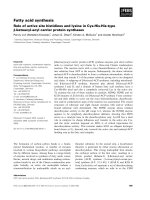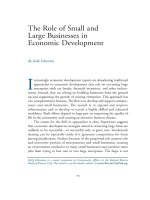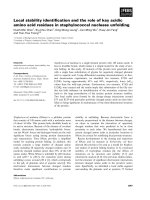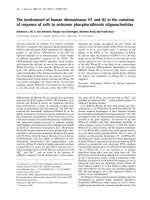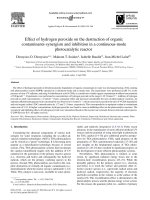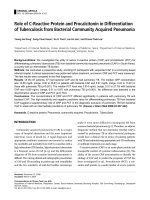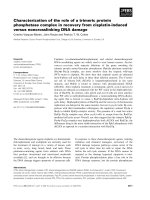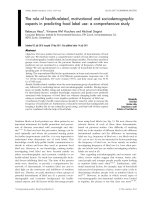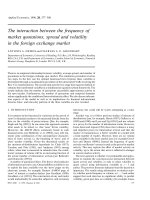The role of small GTPases rap1 and rhoa in growth hormone signal transduction
Bạn đang xem bản rút gọn của tài liệu. Xem và tải ngay bản đầy đủ của tài liệu tại đây (5.78 MB, 246 trang )
THE ROLE OF SMALL GTP
ASES
RAP1 AND RHOA
IN GROWTH HORMONE SIGNAL TRANSDUCTION
LING LING
(MD)
A THESIS SUBMITTED
FOR THE DEGREE OF DOCTOR OF PHILOSOPHY
DEPARTMENT OF PHYSIOLOGY &
INSTITUTE OF MOLECULAR AND CELL BIOLOGY
NATIONAL UNIVERSITY OF SINGAPORE
2004
ii
Acknowledgements
Dr. Peter Lobie, my supervisor and thesis advisor, for his patient guidance, generous
support and scientific advice throughout my study.
Dr Benjamin Li, my co-supervisor, for his generous help in the final stage of my
study.
Dr. Alan Porter and Dr. Cao Xin Min, my supervisory committee members, for their
invaluable advice and critical comments on my work.
Past and present members of IMCB and my laboratory, for their kind help and
stimulating discussion in scientific research.
My family members, for their deep love and moral support.
iii
Table of Contents
Chapter I Introduction
1.1 The growth hormone molecule 2
1.1.1 Growth hormone gene and protein structure 2
1.1.2 Regulation of growth hormone synthesis and secretion 5
1.2 Growth hormone receptor and growth hormone binding protein (GHBP) 7
1.3 Biological effects of growth hormone 11
1.4 Cellular mechanism of growth hormone signal transduction 14
1.4.1 Growth hormone receptor (GHR) and protein tyrosine kinase JAK2 14
1.4.2 Protein tyrosine kinases c-Src, FAK and EGFRs 18
1.4.3 Multiprotein complexes 21
1.4.4 IRS and PI-3 kinase 23
1.4.5 Mitogen-activated protein (MAP) kinase pathway 25
1.4.6 Stat pathway 29
1.5 Transcription cofactors p300/CBP 33
1.6 Ras-related small GTPases 35
1.6.1 Ras superfamily small GTPases 35
1.6.2 Ras 36
1.6.3 Ral 38
1.6.4 Rap1 and Rap2 40
1.6.5 RhoA 43
1.7 Rationale and objectives of research 46
iv
Chapter II Materials and Methods
2.1 Chemicals and reagents 49
2.2 DNA constructs 50
2.3 Antibodies 51
2.4 Cell culture and treatment 52
2.5 Site-directed mutagenesis and polymerase chain reaction (PCR) 52
2.6 Preparation of E. coli competent cells 53
2.7 DNA transformation 54
2.8 DNA preparation 54
2.9 Agarose gel electrophoresis 55
2.10 Purification of GST fusion proteins 55
2.11 Transient transfection of mammalian cells 56
2.12 Nuclear extraction 57
2.13 Immunoprecipitation 57
2.14 SDS-polyacrylamide gel electrophoresis (SDS-PAGE) 58
2.15 Western blot analysis 58
2.16 Immunofluorescence and microscopy 59
2.17 Gel electrophoretic mobility shift assay (GEMSA) 60
2.18 RalA, Rap and Ras activity assays 61
2.19 RhoA activity assay 61
2.20 p44/42 MAP kinase assay 62
2.21 JNK/SAPK assay 62
2.22 PKA kinase activity assay 63
2.23 ROCK activity assay 63
2.24 p300/HAT activity assay 64
v
2.25 Luciferase reporter assay 64
2.26 Densitometric analysis of band intensities 65
2.27 Statistical analysis and presentation of data 65
Chapter III Src-CrkII-C3G Dependent Activation of Rap1 Switches Growth
Hormone Stimulated p44/42 MAP Kinase and JNK/SAPK Activities
3.1 GH stimulation of NIH-3T3 cells increases the level of GTP bound Rap1 and
Rap2. 67
3.2 GH stimulated activation of Rap1 and Rap2 are cell density dependent 69
3.3 Full activation of Rap1 and Rap2 by GH requires both JAK2 and c-Src. 71
3.4 C3G tyrosine phosphorylation is required for GH stimulated Rap1 and Rap2
activation 73
3.5 CrkII-C3G mediates GH stimulated Rap1 and Rap2 activity 78
3.6 Rap1 prevents the sustained p44/42 MAP kinase activity stimulated by GH and
mediates CrkII diminished Elk-1 transcriptional activity 81
3.7 Ras and Rap are activated by GH independent of the other. 87
3.8 RalA is required for GH stimulated p44/42 MAP kinase activity and subsequent
Elk-1 mediated transcription 90
3.9 Rap1 inhibits GH stimulated Elk-1 mediated transcription through inactivation of
RalA 93
3.10 C3G and Rap1 are utilized by CrkII to enhance GH stimulated JNK/SAPK
activity and subsequent c-Jun mediated transcription. 96
vi
Chapter IV RhoA/ROCK Activation by Growth Hormone Abrogates
p300/HDAC6 Repression of Stat5 Mediated Transcription.
4.1 GH stimulation of NIH-3T3 cells increases the activity of RhoA 102
4.2 GH stimulated activation of RhoA requires the kinase activity of JAK2 104
4.3 p190RhoGAP inhibits GH stimulated RhoA activity 106
4.4 JAK2 induced dissociation of RhoA from the complex containing p190RhoGAP
is required for GH stimulated RhoA activation 107
4.5 RhoA does not affect GH stimulated activation of JAK2-p44/42 MAP kinase
pathway 112
4.6 GH stimulates ROCK activity in a RhoA dependent manner 115
4.7 RhoA-ROCK are required for GH stimulated Stat5 mediated transcription 116
4.8 PKA inhibits GH stimulated Stat5 mediated transcription through inactivation of
RhoA 122
4.9 p300 inhibits GH stimulated RhoA mediated Stat5 transcriptional activity by
recruiting HDAC6 128
Chapter V Discussion
Part I: Src-CrkII-C3G dependent activation of Rap1 switches growth hormone
stimulated p44/42 MAP kinase and JNK/SAPK activities 135
Part II: RhoA/ROCK Activation by Growth Hormone Abrogates p300/HDAC6
Repression of Stat5 Mediated Transcription 148
General Discussion and Future Prospectives 157
References
vii
Summary
Growth hormone (GH) is the major regulator of postnatal somatic growth and
exhibits profound effects on cell
growth, differentiation and metabolism. GH
predominantly exerts its functions through stimulation of multiple signaling pathways
leading to activation of gene transcription. GH-stimulated activation of signal
transducers and activators of transcription (Stats), mitogen activated protein (MAP)
kinase and phosphatidylinositol 3 kinase (PI3K) cascades have been shown to
regulate the transcription of GH-responsive genes. The small GTPase Ras is the major
regulator for GH stimulated activation of p44/42 MAP kinase and subsequent Elk-1
mediated transcription. The Ras superfamily of small GTPases exhibit diverse
functions and have been regarded as important mediators in cell signaling. The aim of
this project was to investigate the role of small GTPases Rap1 and RhoA in GH signal
transduction.
Rap1, a close relative of Ras, shares common effectors with Ras and exhibits
an antagonistic effect on Ras activated p44/42 MAP kinase activity. In the first study,
we demonstrated that GH stimulated the activation of Rap1 and Rap2 in NIH-3T3
cells. Full activation of Rap1 and Rap2 by GH required the combined activity of both
JAK2 and c-Src kinases. GH stimulated tyrosine phosphorylation of C3G, a Rap1
specific GEF, which again required the combined activity of JAK2 and c-Src. The
tyrosine residue 504 of C3G was the target of phosphorylation and a CrkII-C3G
pathway was required for GH stimulated Rap activation. Activated Rap1 inhibited GH
stimulated activation of RalA and subsequent p44/42 MAP kinase activity and Elk-1
mediated transcription which were negatively regulated by CrkII through Rap1. We
also demonstrated that C3G-Rap1 mediated CrkII enhancement of GH stimulated
viii
JNK/SAPK activity. Therefore a linear JAK2 independent pathway was identified
switching GH stimulated p44/42 MAP kinase and JNK/SAPK activities.
We also demonstrated that GH stimulated the activation of another small
GTPase RhoA and its substrate, serine/threonine kinase ROCK, in NIH-3T3 cells. GH
stimulated activation of RhoA required JAK2 dependent dissociation of RhoA from
its negative regulator p190RhoGAP. Although RhoA was reported to regulate p44/42
MAP kinase activity, it did not affect GH stimulated JAK2 tyrosine phosphorylation
or p44/42 MAP kinase activity. However, RhoA and ROCK activity were required for
GH stimulated Stat5 mediated transcription. GH stimulated RhoA activity was not
required for the initial activation and DNA binding of Stat5 or degradation of Stat5
molecules. Instead, RhoA dependent enhancement of GH stimulated Stat5 mediated
transcription was due to repression of the recruitment of HDAC6 by transcription
cofactor p300. The results also demonstrated that RhoA was the pivot for PKA
inhibition of GH stimulated Stat5 mediated transcription as a consequence of
inactivation of RhoA through PKA induced phosphorylation on serine residue 188.
Therefore, the small GTPases Rap1 and RhoA are two important regulators for
GH stimulated signal transduction pathways leading to activation of gene
transcription. Combined with the previous demonstration of GH stimulated activation
of Ras, Ral and Rac, the pivotal role of Ras-related small GTPases in GH signaling
has been established.
ix
List of Figures
Fig. 1.1 Schematic representation of the human GH gene cluster
Fig. 1.2 Schematic structure of the GH receptor
Fig. 1.3 Schematic structure of JAKs
Fig. 1.4 Simplified diagrammatic representation of GH signal transduction pathways
Fig. 1.5 Multiprotein complex centered around CrkII and p130Cas stimulated by GH
Fig. 3.1 GH stimulates the formation of GTP bound Rap1 and Rap2 in NIH-3T3 cells
in both a time and dose dependent manner.
Fig. 3.2 GH stimulated activation of Rap1 and Rap2 are regulated by cell density.
Fig. 3.3 Full activation of Rap1 and Rap2 by GH requires both JAK2 and c-Src.
Fig. 3.4 JAK2 and c-Src dependent C3G tyrosine 504 phosphorylation is required for
GH stimulated Rap1 and Rap2 activation.
Fig. 3.5 A CrkII-C3G pathway mediates GH stimulated formation of GTP bound
Rap1 and Rap2.
Fig. 3.6 Rap1 prevents the sustained p44/42 MAP kinase activity stimulated by GH
and mediates CrkII diminished Elk-1 transcriptional activity.
Fig. 3.7 Ras and Rap are activated by GH independent of the other.
Fig. 3.8 RalA is required for GH stimulated p44/42 MAP kinase activity and Elk-1
mediated transcription.
Fig. 3.9 Rap1 inhibits GH stimulated p44/42 MAP kinase through inactivation of
RalA.
Fig. 3.10 CrkII dependent GH stimulated JNK/SAPK activation and subsequent c-Jun
mediated transcription is via C3G and Rap1.
Fig. 4.1 GH stimulates the formation of GTP-bound RhoA in both a time and dose
dependent manner.
Fig. 4.2 GH stimulated activation of RhoA requires kinase activity of JAK2.
Fig. 4.3 p190RhoGAP inhibits GH stimulated RhoA activity.
Fig. 4.4 JAK2 dependent dissociation of RhoA from the complex containing
p190RhoGAP is required for GH stimulated RhoA activation.
x
Fig. 4.5 RhoA does not affect GH stimulated activation of JAK2-p44/42 MAP kinase
pathway.
Fig. 4.6 GH stimulates ROCK activity in a RhoA dependent manner.
Fig. 4.7 RhoA-ROCK are required for GH stimulated Stat5 mediated transcription.
Fig. 4.8 PKA inhibits GH stimulated Stat5 mediated transcription through inactivation
of RhoA.
Fig. 4.9 p300 inhibits GH stimulated RhoA mediated Stat5 transcriptional activity by
recruiting HDAC6.
Fig. 5.1 Schematic diagram of GH stimulated pathways leading to either Elk-1 or c-
Jun mediated transcription.
Fig. 5.2 Schematic diagram of pathways mediated by p300-HDAC6 and RhoA to
regulate GH stimulated Stat5 transcriptional activity.
xi
List of Abbreviations
aa amino acid
APS adapter protein with a PH and SH2 domain molecules
ATF-2 activating transcription factor-2
ATP adenosine triphosphate
bp base pair
BSA bovine serum albumin
cAMP cyclic adenosine monophosphate
Cas Crk-associated substrate
Cbl Casitas B-lineage Lymphoma
CBP CREB binding protein
Cdc cell division cycle
cDNA complimentary deoxylribonucleic acid
C. elegans Caenorhabditis elegans
CHO Chinese hamster ovary
CIS cytokine-inducible SH2 containing protein
CMV cytomegalovirus
CNBr cyanogen bromide
CNTF ciliary neutrophic factor
cpm counts per minute
CRD1 cell cycle regulatory domain 1
CREB c-AMP responsive element binding protein
Crk chicken tumor virus no. 10 regulator of kinase
CSF colony-stimulating factor
Csk carboxyl-terminal Src kinase
xii
C-terminus carboxyl-terminus
CTP cytosine triphosphate
DAG diacylglycerol
dATP deoxy-adenosine triphosphate
ddATP 2',3'-dideoxyadenosine 5'-triphosphate
dCTP deoxy-cytosine triphospate
ddH
2
O double distilled water
DDT dithiothreitol
dIdC deoxyinosinic-deoxycytidylic
DMEM Dulbecco’s modified Eagle’s medium
DMSO dimethyl sulfoxide
DNA deoxyribonucleic acid
DNase deoxyribonuclease
dNTP deoxynucleotide triphosphate
DTT dithiothreitol
E. coli Escherichia coli
ECL enhanced chemilluminescence
ECM extracellular matrix
EDTA ethylenediaminetetra acetic acid
EGF epidermal
growth factor
EGTA ethyleneglycoltetra acetic acid
Elk ETS-related tyrosine kinase
EPO erythropoietin
ER endoplasmic reticulum
ERK extracellular signal regulated kinase
xiii
EtBr ethidium bromide
FAK focal adhesion kinase
FBS fetal bovine serum
FGF fibroblast growth factor
FITC fluorescein isothiocyanate
G protein guanine-nucleotide binding protein
GAP GTPase activating protein
GAS interferon-γ-activated sequence
G-CSF granulocyte colony stimulating factor
GDI guanine-nucleotide dissociation inhibitor
GDP guanosine 5’-diphosphate
GDS guanosine dissociation stimulator
GEF guanine-nucleotide exchange factor
GH growth hormone
GHBP growth hormone-binding protein
GH-N growth
hormone normal gene
GHR growth
hormone receptor
GHRH growth
hormone releasing hormone
GHRP growth hormone releasing peptide
GHS growth hormone secretagogue
GHS-R growth hormone secretagogue receptor
GH-V growth
hormone variant
GLE GAS-like response element
GM-CSF granulocyte-macrophage colony stimulating factor
GR glucocorticoid receptor
xiv
Grb2 growth factor receptor-binding protein 2
GTP guanine 5’-triphosphate
h hour
HAT histone acetyltransferase
hCS human chorionic somatomammotropin
HDAC histone deacetylase
HEPES 4-(2-hdroxyethyl)-1-piperazine-N’ 2-ethane-sulphonic acid
hGH human growth hormone
hIGF-1 human IGF-1
hPL human placental lactogen
HRP horseradish peroxidase
IFN interferon
IGF insulin-like growth
factor
IL interleukin
iNOS inducible nitric oxide synthase
IPTG isopropyl-1-thio-β-D-galactopyranoside
IP3 inositol-1,4,5-triphosphate
IRS insulin receptor substrate
JAK Janus kinase
JH Jak homology
JNK c-Jun N-terminal kinase
kb kilobase
kDa kilo Dalton
LB Luria-Bertani medium
LIF leukemia inhibitory factor
xv
LPA lysophosphatidic acid
LUC luciferase
M molar
MAb monoclonal antibody
MAP mitogen-activated protein
MAPK mitogen-activated protein kinase
MEF
mouse embryo fibroblasts
MEK MAPK/extracellular signal-regulated kinase kinase
MGF mammary gland factor
mDia murine Diaphanous formin
min minute
ml milliliter
mM millimolar
mRNA messenger ribonucleic acid
MOPS 3-(N-morpholino) propanesulfonic acid
MYPT-1 myosin phosphatase target subunit 1
NFκB nuclear factor kappa B
N-terminus amino-terminus
NP-40 Nonidet P 40
o
C degree Celsius
OD optical density
PA phosphatidic acid
PAGE polyacrylamide gel electrophoresis
PAK p21-activated protein kinase
PBS phosphate-buffered saline
xvi
PCR polymerase chain reaction
PDGF platelet-derived growth factor
PI phosphatidylinositol
Pit pituitary-specific transcription factor
PIAS protein inhibitors of activated STATs
PKA protein kinase A
PKC protein kinase C
PL placental lactogen
PLA2 phospholipase 2
PLC phopholipase C
PLD phopholipase D
PMSF phenylmethylsulfonyl fluoride
POU Pit-Oct-Unc
PRL prolactin
Pyk2 proline-rich tyrosine kinase-2
RalBP Ral binding protein
RalGDS Ral GDP dissociation stimulator
Rgl RGS-like
RGS regulators of G protein signaling
RNase ribonuclease
ROCK Rho-associated kinase
rpm revolutions per minute
RSK ribosomal S6 kinase
RTK receptor tyrosine kinases
RT room temperature
xvii
Sap signalling lymphocytic activation molecule (SLAM)-associated
protein
SAPK stress-activated protein kinase
SDS sodium dodecyl sulphate
sec second
SH Src homology
SHC Src homology-containing protein
SHP SH2 domain-containing protein tyrosine phosphatase
SIE sis inducible element
SIRP signal-regulatory proteins
SOCS suppressors of cytokine signaling
Sos Son of sevenless
Spi serine protease inhibitor
SRE serum response element
SRF serum response factor
Src Rous sarcoma carcinoma
SS somatostatin
S6K ribosomal protein S6 kinase
STAM signal-transducing adaptor molecule
STAT signal transducer and activator of transcription.
SUMO small ubiquitin like modifier
TBP TATA box binding protein
TCF ternary complex factor
TGF-β transforming growth factor-β
TRITC tetramethylrhodamine isothiocyanate
xviii
Tris 2-amino-2(hydroxymethyl)-1-3-propanediol
T3 thyroxine
UV ultraviolet
µl microliter
V volts
1
Chapter I
Introduction
2
Growth hormone (GH) is a peptide hormone secreted from the pituitary
gland under the control of the hypothalamus. It belongs to a large family of
evolutionarily conserved hormones including prolactin and placental lactogens
(Kopchick and Andry, 2000). GH is the primary regulator of postnatal somatic growth
and metabolism (Herrington and Carter-Su, 2001). GH acts as an autocrine and
paracrine growth factor to regulate the proliferation (Baixeras et al., 2001; Kaulsay et
al., 1999; Nielsen et al., 1999), apoptosis (Baixeras et al., 2001), differentiation
(Hansen et al., 1998; Nielsen et al., 1999; Shang and Waters, 2003) and chemotaxis
(Lal et al., 2000; Ohlsson et al., 1998) in various cell types. GH exerts its cellular
effects through binding to its specific membrane-bound receptor termed as growth
hormone receptor (GHR), followed by initiation of the activation of sequential
signaling molecules and transcription factors, leading to the transcription of
corresponding genes. In addition to regulation of gene transcription, GH also
participates in the regulation of cytoskeleton reorganization, Ca
2+
influx and glucose
transport (Goh et al., 1997; Gaur et al., 1996; Yokota et al., 1998).
1.1 The growth hormone molecule
1.1.1 Growth hormone gene and protein structure
In human, growth hormone is expressed in the pituitary by the hGH-N gene
that is part of a gene cluster composed of five structurally and functionally related
genes (Fig. 1.1) (Kopchick and Andry, 2000). This 50 kb gene cluster locates on the
3
long arm of human chromosome 17 at bands q22-24 (Miller and Eberhardt, 1983) and
is arranged from 5' to 3' as hGH-N (N for normal), hPL-1 (also known as hCS-L, L
for like), hPL-2 (also known as hCS-A), hGH-V (V for variant) and hPL-3 (also
known as hCS-B), respectively (Okada and Kopchick, 2001; Lewis et al., 2000).
These genes share more than 92 % identity in the coding and flanking sequences
(Miller and Eberhardt, 1983).
Fig.1.1 Schematic representation of the human GH gene cluster The five genes
comprising approximately 8 kb of structural sequences are spread over 50 kb of DNA
on chromasome 17q 22-24. This figure is from Lobie and Waxman, 2003. See text for
details.
4
The proximal promoter of the hGH-N gene, which is 500 bp in length,
contains the TATA box and two bindings sites for the pituitary-specific transcription
factor (Pit-1) GHF-1 (Karin et al., 1990). Pit-1 plays a major role in the pituitary
specific expression of the hGH-N gene (Karin et al., 1990). In addition to mediating
tissue specific expression, this promoter regulates transcription in response to
hormonal signals through the cis-acting elements (Bodner et al., 1988). The remote
sequences of hGH-N promoter, which are 15 kb upstream of the transcription
initiation site, are also required for efficient gene expression (Edens and Talamantes,
1998).
The hGH-N gene is expressed in the pituitary gland as two isoforms of
product, 22 kDa and 20 kDa hGH, generated by alternate splicing (Kopchick and
Andry, 2000; Lewis et al., 2000). The 22 kDa hGH-N is the predominant form and its
transcript comprises 90 % of pituitary gland mRNA (Lewis et al., 1994). The 20 kDa
hGH-N is produced by deletion of amino acid residues 32-46 and constitutes up to 15
% of secreted GH in human (Lewis et al., 2000). There also exists a 17 kDa hGH-N in
circulation which exhibits the diabetogenic action (Sinha and Jacobsen, 1994). The
mature 22 kDa isoform of hGH-N is a 191 amino acid polypeptide and also the major
form of circulating hGH (85 %) (Kopchick and Andry, 2000). The half-life of hGH is
approximately 25 minutes (Zeisel et al., 1992; Li et al., 2001). The three-dimensional
structure of hGH has been determined. It contains four α-helices arranged in a
left-handed bundle orientation with an up-up-down-down topology and two disulfide
5
bridges at four cystine residues (de Vos et al., 1992). The cystine residues form two
loops with different length within GH molecule and the larger one is required for GH
activity (Kopchick and Andry, 2000).
The nucleotide and amino acid sequence of GH from several species has
been determined (Kopchick and Andry, 2000). The nucleotide sequence identity
among human, rat and bovine GH is approximately 75-77 %. The amino acid
sequence of bovine GH shares higher identity with that of ovine GH (99 %) than hGH
(75 %). Rat and mouse GH exhibit 95 % and 92 % similarity in amino acid sequence,
respectively, to that of ruminants (Kopchick and Andry, 2000). Among the studied
species, only primate GH binds to the hGH receptor (Souza et al., 1995). Under
certain conditions hGH also binds and activates the PRL receptor (Fuh and Wells,
1995).
1.1.2 Regulation of growth hormone synthesis and secretion
GH is produced by somatotrophs located in the anterior pituitary gland (Le
Roith et al., 2001). GH is also expressed in the central nervous system (Gossard et al.,
1987), bone marrow and thymus (Binder et al., 1994), mammary gland (Selman et al.,
1994; Mertani et al., 2001), gonads from both sexes (Izadyar et al., 1999; Untergasser
et al., 1997), placenta (Boguszewski et al., 1998) and lymphocytes (Hattori et al.,
1999).
6
The physiological synthesis and secretion of GH from the anterior pituitary
gland are controlled mainly by two hypothalamic neuropeptides, GH releasing
hormone (GHRH) and somatostatin (SRIF) (Muller et al., 1999). GHRH produced
from the hypothalamus binds to and activates a specific GHRH receptor which is a
G-protein coupled receptor on the somatotrophs and increases the level of
intracellular cAMP, which in turn increases the concentration of the pituitary specific
factor, Pit-1 (Shim and Cohen, 1999; Sekkali et al., 1999). Pit-1 belongs to POU
homeodomain family of transcription factors and binds to multiple binding sites in the
proximal promoter region of the hGH-N gene to stimulate transcription (Shewchuk et
al., 1999). It has been reported that mutations in the Pit-1 gene are clinically
associated with severe deficiencies of hGH and hypothyroidism (Pfaffle et al., 1999).
GHRH also increases intracellular Ca
2+
, which in turn stimulates the release of GH
(Morishita et al., 2003). Hypothalamic derived somatostatin inhibits GH release
through reduction of cAMP concentration and/or hyperpolarization of the cells via
SRIF receptors (Morishita et al., 2003; Gaylinn et al., 1999). It has recently
demonstrated that the effect of both GHRH and SRIF on GH gene transcription is
mediated through pertussis toxin-sensitive G protein (Morishita et al., 2003).
GH releasing peptides (GHRPs) is a class of synthetic molecules that can
stimulate GH release via stimulation of the GH secretagogue receptor (GHS-R), a
seven-transmembrane G-protein coupled receptor expressed in the pituitary (Howard
et al., 1996; Kopchick and Andry, 2000). Ghrelin, a 28 amino acid peptide isolated
7
from stomach extracts, is the endogenous ligand that binds and activates the GHS-R
(Kojima et al., 1999). Another ligand for GHS-R is des-Gln14-Ghrelin that is formed
by alternative splicing of the Ghrelin gene and also promotes GH release (Kojima et
al., 1999).
GH release is also regulated by free fatty acid, leptin and neuropeptide Y
(Smith et al., 1996; Howard et al., 1996; Butler and Le Roith, 2001). The direct action
of free fatty acid on the pituitary is to inhibit GH release and is postulated to form a
feedback loop since GH stimulates lipid mobilization (Butler and Le Roith, 2001). In
rodents, leptin stimulates GH production by regulating GHRH and somatostatin
activity (Vuagnat et al., 1998; Carro et al., 1997; Tannenbaum et al., 1998). It has
also been suggested that the effect of leptin on GH secretion may be achieved through
inhibition of neuropeptide Y expression by leptin (Chan et al., 1996). GH release is
also regulated by behaviors. It has been reported that stress, sleep and exercise can
elevate GH level via stimulation of GHRH production (Kopchick and Andry, 2000).
1.2 Growth hormone receptor and growth hormone binding protein (GHBP)
GH exerts cellular effects through binding to the transmembrane GH
receptor (GHR) (Fig. 1.2), which is present on the surface of most cells (Kelly et al.,
1993). GHR was the first identified member of type I cytokine receptor superfamily
which includes prolactin (PRL) receptor, erythropoietin (EPO) receptor,
thrombopoietin receptor, granulocyte macrophage colony stimulating factor
